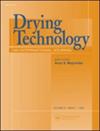超声波功率对接触超声增强远红外辐射干燥芋头片水分迁移及微观结构的影响
IF 2.7
3区 工程技术
Q3 ENGINEERING, CHEMICAL
引用次数: 1
摘要
摘要为了阐明接触超声增强远红外辐射干燥(CUFRD)过程中芋头水分迁移和微观结构的变化,采用低场核磁共振(NMR)、扫描电镜(SEM)、石蜡切片和显微观察等技术,探讨了芋头干燥曲线、水分状态、微观结构、孔隙度、水分含量、水分含量和水分含量的变化。不同超声功率0、40、80 W下芋头细胞微观结构参数的显微图像及分布曲线。结果表明,在干燥过程中应用接触超声(CU)有利于加速芋头片的脱水过程,提高其孔隙率。随着CU功率的增加,芋头干燥次数减少16.67% ~ 25.00%,有效水分扩散系数提高14.72% ~ 31.38%。此外,CU的施用导致芋头细胞的横截面积和周长分布曲线先增大后减小,芋头细胞圆度分布曲线的峰形变宽。综上所述,CU能加快芋头内部水分迁移,且CU功率越大,对CUFRD过程中芋头微观结构和细胞形态参数的影响越明显。本文章由计算机程序翻译,如有差异,请以英文原文为准。
Effect of ultrasonic power on moisture migration and microstructure of contact ultrasound enhanced far-infrared radiation drying on taro slices
Abstract To clarify the moisture migration and microstructure of taro in contact ultrasound enhanced far-infrared radiation drying (CUFRD), low-field nuclear magnetic resonance (NMR), scanning electron microscopy (SEM), paraffin sectioning and microscopic observation techniques were applied to explore the changes of the drying curves, water status, microstructure, porosity, microscopic images and distribution curves of cell microstructure parameters of taro under different ultrasound powers of 0, 40, and 80 W. The results showed that applying contact ultrasound (CU) during drying was beneficial to accelerating the dehydration process and improving the porosity of taro slice. With the augment of CU power, the drying times of taro reduced by 16.67% to 25.00%, and the effective water diffusion coefficient was improved by 14.72% to 31.38%. In addition, the application of CU resulted in an increase firstly and then decrease in the cross-sectional area and perimeter distribution curves of taro cells and a widening of the peak shape of the distribution curve of taro cell roundness. In conclusion, CU application could cause faster internal moisture migration, and higher CU power had more obvious effect on microstructure and cell morphological parameters of taro during CUFRD.
求助全文
通过发布文献求助,成功后即可免费获取论文全文。
去求助
来源期刊

Drying Technology
工程技术-工程:化工
CiteScore
7.40
自引率
15.20%
发文量
133
审稿时长
2 months
期刊介绍:
Drying Technology explores the science and technology, and the engineering aspects of drying, dewatering, and related topics.
Articles in this multi-disciplinary journal cover the following themes:
-Fundamental and applied aspects of dryers in diverse industrial sectors-
Mathematical modeling of drying and dryers-
Computer modeling of transport processes in multi-phase systems-
Material science aspects of drying-
Transport phenomena in porous media-
Design, scale-up, control and off-design analysis of dryers-
Energy, environmental, safety and techno-economic aspects-
Quality parameters in drying operations-
Pre- and post-drying operations-
Novel drying technologies.
This peer-reviewed journal provides an archival reference for scientists, engineers, and technologists in all industrial sectors and academia concerned with any aspect of thermal or nonthermal dehydration and allied operations.
 求助内容:
求助内容: 应助结果提醒方式:
应助结果提醒方式:


